Investigation into PV Inverter Topologies from the Standards Compliance Viewpoint
Abstract
:1. Introduction
2. Different Standards on PV Inverter Performance
2.1. UL1741
- Enhanced Grid Support Functions
- Soft Start Ramp Rates: Inverters are to provide predictable, smooth power production ramp rates when connecting to the grid.
- Power Factor Application: Inverters are to apply a specified power factor to maintain grid stability.
- Reactive Power Control: Inverters have to manage grid voltage by providing reactive power.
- Active Power Control: Inverters are required to regulate grid voltage and frequency by controlling the power output.
- Extended Operating Range: Inverters must stay connected during minor voltage and frequency fluctuations, supporting the grid rather than disconnecting. This is a significant shift from previous mandates that required inverters to disconnect immediately upon detecting out-of-range voltage or frequency.
- Ride-Through Capability: Inverters are required to ride through grid instability events, maintaining their connection and supporting grid stability rather than tripping offline. This capability, known as ride-through, ensures that renewables strengthen the grid during instability rather than contributing to the problem.
- Autonomous Operation: The new standards mandate that inverters operate autonomously without a direct communication link to utility companies. Inverters continuously monitor the grid locally and respond based on real-time conditions.
- Shutdown Protocol for Safety: In case of a power outage, UL1741-SA requires inverters to shut down to prevent back-feeding electricity into the grid, which could endanger first responders and utility line workers.
2.2. IEEE 1547
- Interconnection and Interoperability: The primary goal of these standards is to establish uniform guidelines for the interconnection and interoperability of distributed energy resources (DER) with electric power systems (EPS). This includes defining requirements for performance, operation, testing, safety, maintenance, and security considerations.
- Supporting Grid Performance and Reliability: The standards aim to ensure that grid performance and reliability levels are maintained or enhanced when integrating DER with the grid. By providing engineering consensus on proper interconnection practices, these standards help maintain grid stability even with high levels of DER penetration.
- Facilitating Advanced DER Projects: The standards seek to reduce interconnection approval time and costs for advanced DER projects. By streamlining the approval process and providing clear guidelines, these standards support the efficient integration of new technologies into the grid.
- Enabling Future Grid Evolution: IEEE 1547 Standards is crucial for the evolution of the electricity infrastructure. They provide a technological basis for updating implementation rules and agreements to accommodate advanced grid support features and customer interactive capabilities, ultimately contributing to grid reliability and robustness.
- Promoting Industry Collaboration: These standards foster collaboration between technology manufacturers, utilities, authorities having jurisdiction (AHJs), and other stakeholders. By establishing a common framework, the standards facilitate effective communication and coordination among the different entities involved in DER integration.
- Voltage Regulation: The standard defines two performance categories for distributed energy resources (DERs) with voltage regulation capabilities. Category A covers the minimum performance capabilities needed for area electric power system (EPS) voltage regulation, while Category B addresses advanced performance capabilities. Additionally, the standard mandates voltage regulation capability for DERs, but the performance is proposed to be at the utility’s discretion.
- Power Quality: The standard addresses power quality concerns such as flicker, which is defined as the subjective impression of fluctuating luminance caused by voltage fluctuations. Assessment and measurement methods for flicker are defined in IEEE 1453 and IEC 61000-3-7
- Ride-Through: The ride-through requirements are designed for distribution support as well as bulk system reliability, based on California Rule 21 and Hawaii Rule 14H. The standard specifies that Category II and III ride-through capabilities are sufficient for bulk system reliability.
2.3. CSA 22.2
- Scope and Applicability: The CSA C22.2 standards apply to a broad spectrum of electrical equipment, including PV inverters, converters, controllers, and other interconnection system equipment used in DERs.
- Safety Requirements
- Electrical Safety: Specifications for insulation, grounding, and protection against overcurrent and electric shock hazards.
- Mechanical Safety: Requirements for mechanical integrity, including construction of enclosures, protection against environmental factors (e.g., dust, moisture), and robustness against physical impacts.
- Thermal Safety: Guidelines to manage heat dissipation and prevent overheating and fire hazards.
- Performance and Reliability:
- Quality Assurance: Standards to ensure the consistent quality and reliability of equipment over its expected operational life.
- Functional Performance: Criteria for operational performance under various environmental and grid conditions, including voltage and frequency variations.
- Grid Interconnection:
- Interoperability: Ensuring compatibility with Canadian grid requirements and other relevant standards, such as IEEE 1547 for DER interconnection.
- Anti-Islanding Protection: Requirements to prevent inverters from continuing to power isolated sections of the grid, enhancing safety during grid disturbances.
2.4. IEC 62109
- IEC 62109-1: General requirements for the design and construction of PV inverters to ensure basic safety principles are met. This part covers electrical, mechanical, thermal, and environmental aspects, ensuring that the inverters are robust and safe under various operating conditions.
- IEC 62109-2: Specific requirements for particular types of inverters, addressing additional risks and safety measures that may apply to specific technologies or configurations. The key safety requirements described by IEC standards are as follows:
- Electrical Safety:
- Insulation and Grounding: Specifications for adequate insulation and grounding to prevent electric shock hazards.
- Protection Against Overcurrent: Requirements for protective devices to prevent damage from overcurrent conditions.
- Isolation: Standards for electrical isolation to safeguard users and maintain system integrity.
- Mechanical Safety:
- Construction: Guidelines for the physical construction of inverters, including the durability of enclosures, protection against the ingress of solid objects and liquids, and resistance to mechanical impacts.
- Mounting and Accessibility: Standards ensuring that inverters can be safely installed, maintained, and accessed without risk to personnel.
- Thermal Safety:
- Overheating Protection: Requirements for managing heat dissipation to prevent overheating, including specifications for thermal management systems and materials.
- Fire Safety: Guidelines to minimize the risk of fire, including the use of flame-retardant materials and fire containment measures.
- Environmental Safety:
- Weather Resistance: Standards for inverters to withstand various environmental conditions, including temperature extremes, humidity, and exposure to UV radiation.
- Durability: Requirements for long-term durability and reliability under normal operating conditions and environmental stresses.
2.5. VDE
- VDE 0100 Series:
- Focus: Installation of low-voltage systems.
- Content: General protective measures and requirements for electrical installations to ensure functionality and user safety.
- VDE 0105-100:
- Focus: Operation of electrical installations.
- Content: Requirements for the proper operation and maintenance of electrical installations.
- VDE 0701-0702:
- Focus: Testing after repair and periodic testing of electrical equipment.
- Content: Regulations for safety testing of electrical devices post-repair or during regular maintenance.
- VDE 0500 Series:
- Focus: Electrical safety of machines and systems.
- Content: Ensures safety and regulates various converters such as transformers and storage devices (batteries, accumulators).
- VDE 0600 Series:
- Focus: Installation material of electronic devices.
- Content: Nominal specifications for standardized installation materials like switches.
3. Review of Different PV Inverter Topologies
- Grid-connected/Stand-Alone Operation Capability: The ability to operate efficiently in grid-connected or stand-alone modes as required.
- Isolation: Providing isolation between the input and output to ensure safety and proper functioning of the system.
- Power Decoupling: The capability to decouple power flow between input and output stages for better control and efficiency.
- Number of Processing Stages: The number of stages involved in power processing, which can impact system complexity and efficiency.
- Dual Grounding Capability: Ability to support dual grounding for safety and compliance with standards.
- Power Handling Capability: The capacity to handle the power requirements of the PV system effectively.
- Components Count: Keeping the number of components at an optimal level to reduce cost and complexity.
- Size: Optimal sizing of components and the overall system to meet space and installation requirements.
- Wide Range of Operation Capability: Ability to operate efficiently over a wide range of operating conditions.
- Cooling Requirement: Efficient cooling mechanisms to maintain the temperature of components within safe limits.
- Symmetrical Operation: Operating in a symmetrical manner in both half cycles to minimize DC component injection into the grid/load.
- Filter Requirement on the AC Side: Incorporating necessary filters on the AC side to meet grid standards and ensure power quality.
- Complexity Level of Control Strategy: Implementing control strategies that are effective yet manageable for the specific PV application.
- Line-frequency inverters: Appropriate for low-power applications such as AC module configurations [76].
- High-switching frequency voltage source inverters (VSI): Suitable for low- and medium-power PV systems like multi-string and string configurations.
3.1. Single Stage Inverters
3.2. Multi Stage Inverters
3.3. Boost and Buck-Boost Type Topologies
3.4. Two Stage Inverters
3.5. Line Frequency Inverters
3.6. High Switching Frequency Inverters
3.7. Resonant Switching Inverters
3.8. Emerging Trends in PV Inverter Topology and Control Strategies
4. Investigation of Different PV Inverter Topologies for Standards Compliance
4.1. Quantified Compliance Methodology
4.2. Case Study and Numerical Analysis
5. Discussion
6. Conclusions
Author Contributions
Funding
Data Availability Statement
Conflicts of Interest
References
- Varughese, R.A.; Karpagam, D.R. Prediction of Solar Power Generation Based on Machine Learning Algorithm. In Proceedings of the 2022 Third International Conference on Intelligent Computing Instrumentation and Control Technologies (ICICICT), Kannur, India, 11–12 August 2022; pp. 396–400. [Google Scholar] [CrossRef]
- Pourasl, H.H.; Barenji, R.V.; Khojastehnezhad, V.M. Solar energy status in the world: A comprehensive review. Energy Rep. 2023, 10, 3474–3493. [Google Scholar] [CrossRef]
- Elavarasan, R.M.; Shafiullah, G.; Padmanaban, S.; Kumar, N.M.; Annam, A.; Vetrichelvan, A.M.; Mihet-Popa, L.; Holm-Nielsen, J.B. A Comprehensive Review on Renewable Energy Development, Challenges, and Policies of Leading Indian States with an International Perspective. IEEE Access 2020, 8, 74432–74457. [Google Scholar] [CrossRef]
- S. Pilehvar, M.; Mirafzal, B. Frequency and Voltage Supports by Battery-Fed Smart Inverters in Mixed-Inertia Microgrids. Electronics 2020, 9, 1755. [Google Scholar] [CrossRef]
- Nassif, A.B.; Dong, M. Characterizing the Effect of Conservation Voltage Reduction on the Hosting Capacity of Inverter-Based Distributed Energy Resources. Electronics 2020, 9, 1517. [Google Scholar] [CrossRef]
- Arbab-Zavar, B.; Palacios-Garcia, E.J.; Vasquez, J.C.; Guerrero, J.M. Smart Inverters for Microgrid Applications: A Review. Energies 2019, 12, 840. [Google Scholar] [CrossRef]
- Fujimoto, Y.; Kaneko, A.; Iino, Y.; Ishii, H.; Hayashi, Y. Challenges in Smartizing Operational Management of Functionally-Smart Inverters for Distributed Energy Resources: A Review on Machine Learning Aspects. Energies 2023, 16, 1330. [Google Scholar] [CrossRef]
- Xue, Y.; Guerrero, J.M. Smart Inverters for Utility and Industry Applications. In Proceedings of the PCIM Europe 2015; International Exhibition and Conference for Power Electronics, Intelligent Motion, Renewable Energy and Energy Management, Nuremberg, Germany, 19–20 May 2015; pp. 1–8. [Google Scholar]
- Mirafzal, B.; Adib, A. On Grid-Interactive Smart Inverters: Features and Advancements. IEEE Access 2020, 8, 160526–160536. [Google Scholar] [CrossRef]
- Li, Y.; Yan, J. Cybersecurity of Smart Inverters in the Smart Grid: A Survey. IEEE Trans. Power Electron. 2023, 38, 2364–2383. [Google Scholar] [CrossRef]
- Xue, Y.; Starke, M.; Dong, J.; Olama, M.; Kuruganti, T.; Taft, J.; Shankar, M. On a Future for Smart Inverters with Integrated System Functions. In Proceedings of the 2018 9th IEEE International Symposium on Power Electronics for Distributed Generation Systems (PEDG), Charlotte, NC, USA, 25–28 June 2018; pp. 1–8. [Google Scholar] [CrossRef]
- Maharjan, M.; Tamrakar, U.; Ni, Z.; Bhattarai, B.; Tonkoski, R. Overvoltage Prevention and Curtailment Reduction Using Adaptive Droop-Based Supplementary Control in Smart Inverters. Appl. Sci. 2021, 11, 7900. [Google Scholar] [CrossRef]
- Spring, A.; Wirth, G.; Becker, G.; Pardatscher, R.; Witzmann, R. Grid Influences from Reactive Power Flow of Photovoltaic Inverters with a Power Factor Specification of One. IEEE Trans. Smart Grid 2016, 7, 1222–1229. [Google Scholar] [CrossRef]
- Keyhani, A.; Chatterjee, A. Automatic Generation Control Structure for Smart Power Grids. IEEE Trans. Smart Grid 2012, 3, 1310–1316. [Google Scholar] [CrossRef]
- Sun, L.; You, F. Machine Learning and Data-Driven Techniques for the Control of Smart Power Generation Systems: An Uncertainty Handling Perspective. Engineering 2021, 7, 1239–1247. [Google Scholar] [CrossRef]
- Sabhaya, H.V.; Sheth, V.S. Notice of Removal: Comparative analysis of cascade h-bridge multilevel voltage source inverter. In Proceedings of the 2015 International Conference on Electrical, Electronics, Signals, Communication and Optimization (EESCO), Visakhapatnam, India, 24–25 January 2015; pp. 1–6. [Google Scholar] [CrossRef]
- Brovanov, S.V.; Egorov, S.D.; Dubkov, I.S. Study on the efficiency at h-bridge cascaded VSI for different PWM methods. In Proceedings of the 2014 15th International Conference of Young Specialists on Micro/Nanotechnologies and Electron Devices (EDM), Novosibirsk, Russia, 30 June—4 July 2014; pp. 440–443. [Google Scholar] [CrossRef]
- Tian, F.; Al-Atrash, H.; Kersten, R.; Scholl, C.; Siri, K.; Batarseh, I. A single-staged PV array-based high-frequency link inverter design with grid connection. In Proceedings of the APEC ’06, Twenty-First Annual IEEE Applied Power Electronics Conference and Exposition, Dallas, TX, USA, 19–23 March 2006; p. 4. [Google Scholar] [CrossRef]
- Fallah, M.; Kojabadi, H.M.; Naebi, A.; Shenava, S.J.S.; Chang, L. A novel symmetrical cascade h-bridge multi-level inverter topology with reduced switching devices. In Proceedings of the 2016 IEEE 8th International Power Electronics and Motion Control Conference (IPEMC-ECCE Asia), Hefei, China, 22–26 May 2016; pp. 2389–2393. [Google Scholar] [CrossRef]
- Amari, Y.; Hasni, M.; Menaa, M. Comparison between existing transformer-less PV inverter topologies. In Proceedings of the 2018 International Conference on Electrical Sciences and Technologies in Maghreb (CISTEM), Algiers, Algeria, 28–31 October 2018; pp. 1–6. [Google Scholar] [CrossRef]
- Deshpande, S.; Bhasme, N.R. A review of topologies of inverter for grid connected PV systems. In Proceedings of the 2017 Innovations in Power and Advanced Computing Technologies (i-PACT), Vellore, India, 21–22 April 2017; pp. 1–6. [Google Scholar] [CrossRef]
- Yao, Z.; Zhang, Y.; Hu, X. Transformerless Grid-Connected PV Inverter without Common Mode Leakage Current and Shoot-Through Problems. IEEE Trans. Circuits Syst. II Express Briefs 2020, 67, 3257–3261. [Google Scholar] [CrossRef]
- Guo, X.; Yang, Y.; Zhu, T. ESI: A Novel Three-Phase Inverter with Leakage Current Attenuation for Transformerless PV Systems. IEEE Trans. Ind. Electron. 2018, 65, 2967–2974. [Google Scholar] [CrossRef]
- Kjaer, S.; Pedersen, J.; Blaabjerg, F. A review of single-phase grid-connected inverters for photovoltaic modules. IEEE Trans. Ind. Appl. 2005, 41, 1292–1306. [Google Scholar] [CrossRef]
- Dogga, R.; Pathak, M. Recent trends in solar PV inverter topologies. Sol. Energy 2019, 183, 57–73. [Google Scholar] [CrossRef]
- Sharma, S.; Gupta, N. An Overview on Topology and Control Techniques for Solar PV System. In Proceedings of the 2022 1st International Conference on Sustainable Technology for Power and Energy Systems (STPES), Srinagar, India, 4–6 July 2022; pp. 1–6. [Google Scholar] [CrossRef]
- Bughneda, A.; Salem, M.; Richelli, A.; Ishak, D.; Alatai, S. Review of Multilevel Inverters for PV Energy System Applications. Energies 2021, 14, 1585. [Google Scholar] [CrossRef]
- Kjær, S.B.; Pedersen, J.K.; Blaabjerg, F. Power inverter topologies for photovoltaic modules—A review. In Proceedings of the Conference Record of the 2002 IEEE Industry Applications Conference. 37th IAS Annual Meeting (Cat. No.02CH37344), Pittsburgh, PA, USA, 13–18 October 2002; Volume 2, pp. 782–788. [Google Scholar]
- Kolantla, D.; Mikkili, S.; Pendem, S.R.; Desai, A.A. Critical review on various inverter topologies for PV system architectures. IET Renew. Power Gener. 2020, 14, 3418–3438. [Google Scholar] [CrossRef]
- Nyamathulla, S.; Chittathuru, D. A Review of Multilevel Inverter Topologies for Grid-Connected Sustainable Solar Photovoltaic Systems. Sustainability 2023, 15, 13376. [Google Scholar] [CrossRef]
- Mehta, S.; Puri, V. A review of different multi-level inverter topologies for grid integration of solar photovoltaic system. Renew. Energy Focus 2022, 43, 263–276. [Google Scholar] [CrossRef]
- Prakash, G.; Dhineshkumar, K.; Muthamizhan, T.; Rathnavel, P. A Review of Multilevel Inverter Topologies for Solarphotovoltaic System. In Proceedings of the 2022 International Conference on Computer, Power and Communications (ICCPC), Chennai, India, 14–16 December 2022; pp. 632–639. [Google Scholar] [CrossRef]
- Vairavasundaram, I.; Varadarajan, V.; Pavankumar, P.J.; Kanagavel, R.K.; Ravi, L.; Vairavasundaram, S. A Review on Small Power Rating PV Inverter Topologies and Smart PV Inverters. Electronics 2021, 10, 1296. [Google Scholar] [CrossRef]
- Zeb, K.; Uddin, W.; Khan, M.A.; Ali, Z.; Ali, M.U.; Christofides, N.; Kim, H. A comprehensive review on inverter topologies and control strategies for grid connected photovoltaic system. Renew. Sustain. Energy Rev. 2018, 94, 1120–1141. [Google Scholar] [CrossRef]
- Kavya Santhoshi, B.; Mohana Sundaram, K.; Padmanaban, S.; Holm-Nielsen, J.B.; K. K., P. Critical Review of PV Grid-Tied Inverters. Energies 2019, 12, 1921. [Google Scholar] [CrossRef]
- IEEE Std 1547-2018 (Revision of IEEE Std 1547-2003); IEEE Standard for Interconnection and Interoperability of Distributed Energy Resources with Associated Electric Power Systems Interfaces. IEEE Standards Association: Piscataway, NJ, USA, 2018; pp. 1–138. [CrossRef]
- Gonzalez, S.; Johnson, J.; Reno, M.J.; Zgonena, T. Small commercial inverter laboratory evaluations of UL 1741 SA grid-support function response times. In Proceedings of the 2016 IEEE 43rd Photovoltaic Specialists Conference (PVSC), Portland, OR, USA, 5–10 June 2016; pp. 1790–1795. [Google Scholar] [CrossRef]
- Pillai, D.S.; Natarajan, R. A Compatibility Analysis on NEC, IEC, and UL Standards for Protection Against Line–Line and Line–Ground Faults in PV Arrays. IEEE J. Photovolt. 2019, 9, 864–871. [Google Scholar] [CrossRef]
- Shrestha, A.; Cater-Steel, A.; Toleman, M.; Rout, T. Benefits and relevance of International Standards in a design science research project for process assessments. Comput. Stand. Interfaces 2018, 60, 48–56. [Google Scholar] [CrossRef]
- Mahmud, R.; Hoke, A.; Narang, D. Validating the test procedures described in UL 1741 SA and IEEE P1547.1. In Proceedings of the 2018 IEEE 7th World Conference on Photovoltaic Energy Conversion (WCPEC) (A Joint Conference of 45th IEEE PVSC, 28th PVSEC and 34th EU PVSEC), Waikoloa, HI, USA, 10–15 June 2018; pp. 1445–1450. [Google Scholar] [CrossRef]
- Certified safe PV power and grid connect. Photovolt. Bull. 2002, 2002, 4. [CrossRef]
- Malik, A.; Haque, A.; Kurukuru, V.B.; Khan, M.A.; Blaabjerg, F. Overview of fault detection approaches for grid connected photovoltaic inverters. E-Prime-Adv. Electr. Eng. Electron. Energy 2022, 2, 100035. [Google Scholar] [CrossRef]
- IEEE Std 1547a-2020 (Amendment to IEEE Std 1547-2018); IEEE Standard for Interconnection and Interoperability of Distributed Energy Resources with Associated Electric Power Systems Interfaces–Amendment 1: To Provide More Flexibility for Adoption of Abnormal Operating Performance Category III. IEEE Standards Association: Piscataway, NJ, USA, 2020; pp. 1–16. [CrossRef]
- Barth, R.; Chakkalakal, F. Introduction to the new Standards—IEEE STD 844.1™-2017 /CSA C22.2 No. 293.1-17 and IEEE STD 844.2™-2017/CSA C293.2-17 for Skin Effect Trace Heating of Pipelines, Vessels, Equipment, and Structures: Copyright Material IEEE, Paper No. PCIC-2018-20. In Proceedings of the 2018 IEEE Petroleum and Chemical Industry Technical Conference (PCIC), Cincinnati, OH, USA, 24–26 September 2018; pp. 171–178. [Google Scholar] [CrossRef]
- Barth, R.; Fenster, N.; Chakkalakal, F. Introduction to the New Standards—IEEE STD 844.3™-2019 /CSA C22.2 No. 293.3-19 and IEEE STD 844.4™-2019/CSA C293.4-19 for Impedance Heating of Pipelines and Equipment. In Proceedings of the 2021 IEEE IAS Petroleum and Chemical Industry Technical Conference (PCIC), San Antonio, TX, USA, 13–16 September 2021; pp. 183–190. [Google Scholar] [CrossRef]
- Wiguna, R.B.; Grapurwa, G.; Munnahar, A. Technical and Economic Viability of PV Power Plants Construction for Rural Area in Nunukan North Kalimantan. In Proceedings of the 2022 5th International Conference on Power Engineering and Renewable Energy (ICPERE), Bandung, Indonesia, 22–23 November 2022; Volume 1, pp. 1–6. [Google Scholar] [CrossRef]
- Wijesinghe, J.K.; Najim, M.Y.M.; Fernando, G.L.; Liyanage, M.H. Economic Viability of Solar PV for Domestic Applications in a Middle-Income Country: A case Study of Sri Lanka. In Proceedings of the 2020 International Conference and Utility Exhibition on Energy, Environment and Climate Change (ICUE), Pattaya, Thailand, 20–22 October 2020; pp. 1–10. [Google Scholar] [CrossRef]
- Satapathy, P.; Dhar, S.; Dash, P. An evolutionary online sequential extreme learning machine for maximum power point tracking and control in multi-photovoltaic microgrid system. Renew. Energy Focus 2017, 21, 33–53. [Google Scholar] [CrossRef]
- IEEE Std 1547.9-2022; IEEE Guide for Using IEEE Std 1547 for Interconnection of Energy Storage Distributed Energy Resources with Electric Power Systems. IEEE Standards Association: Piscataway, NJ, USA, 2022; pp. 1–87. [CrossRef]
- Anderson, B.; Rane, J.; Khan, R. Distributed wind-hybrid microgrids with autonomous controls and forecasting. Appl. Energy 2023, 333, 120557. [Google Scholar] [CrossRef]
- Mohd Razif, A.S.; Ab Aziz, N.F.; Ab Kadir, M.Z.A.; Kamil, K. Accelerating energy transition through battery energy storage systems deployment: A review on current status, potential and challenges in Malaysia. Energy Strategy Rev. 2024, 52, 101346. [Google Scholar] [CrossRef]
- Nassif, A.B.; Greenwood-Madsen, T.; Azad, S.P.; Teshome, D.F. Feeder Voltage Management through Smart Inverter Advanced Functions and Battery Energy Storage System. In Proceedings of the 2018 IEEE Power and Energy Society General Meeting (PESGM), Portland, OR, USA, 5–10 August 2018; pp. 1–5. [Google Scholar] [CrossRef]
- Shah, P.; Singh, B. Leakage Current Suppression in Double Stage SECS Enabling Harmonics Suppression Capabilities. IEEE Trans. Energy Convers. 2021, 36, 186–196. [Google Scholar] [CrossRef]
- Sarkar, S.; Bhaskar, M.; Uma Rao, K.; V, P.; Almakhles, D.; Subramaniam, U. Solar PV network installation standards and cost estimation guidelines for smart cities. Alex. Eng. J. 2022, 61, 1277–1287. [Google Scholar] [CrossRef]
- Srinivas, V.L.; Singh, B.; Mishra, S. Enhanced Power Quality PV Inverter with Leakage Current Suppression for Three-Phase SECS. IEEE Trans. Ind. Electron. 2022, 69, 5756–5767. [Google Scholar] [CrossRef]
- Lakshika, K.; Boralessa, M.S.; Perera, M.K.; Wadduwage, D.P.; Saravanan, V.; Hemapala, K.U. Reconfigurable solar photovoltaic systems: A review. Heliyon 2020, 6, e05530. [Google Scholar] [CrossRef]
- Chen, Y.M.; Liu, Y.C.; Hung, S.C.; Cheng, C.S. Multi-Input Inverter for Grid-Connected Hybrid PV/Wind Power System. IEEE Trans. Power Electron. 2007, 22, 1070–1077. [Google Scholar] [CrossRef]
- Salem, O.M.; Fetyan, K.M.; Hashim, M.A. Single Stage Solar PV Inverter Equipped to Water Pumping System. In Proceedings of the 2021 22nd International Middle East Power Systems Conference (MEPCON), Assiut, Egypt, 14–16 December 2021; pp. 353–359. [Google Scholar] [CrossRef]
- Jain, S.; Agarwal, V. A Single-Stage Grid Connected Inverter Topology for Solar PV Systems with Maximum Power Point Tracking. IEEE Trans. Power Electron. 2007, 22, 1928–1940. [Google Scholar] [CrossRef]
- Zakzouk, N.E.; Abdelsalam, A.K.; Helal, A.A.; Williams, B.W. High Performance Single-Phase Single-Stage Grid-Tied PV Current Source Inverter Using Cascaded Harmonic Compensators. Energies 2020, 13, 380. [Google Scholar] [CrossRef]
- Mittal, A.; Janardhan, K.; Ojha, A. Multilevel inverter based Grid Connected Solar Photovoltaic System with Power Flow Control. In Proceedings of the 2021 International Conference on Sustainable Energy and Future Electric Transportation (SEFET), Hyderabad, India, 21–23 January 2021; pp. 1–6. [Google Scholar] [CrossRef]
- Shehadeh, S.H.; Aly, H.H.; El-Hawary, M.E. Photovoltaic multi-level inverters technology. In Proceedings of the 2015 IEEE 28th Canadian Conference on Electrical and Computer Engineering (CCECE), Halifax, NS, Canada, 3–6 May 2015; pp. 648–655. [Google Scholar] [CrossRef]
- Tarassodi, P.; Siadatan, A.; Keshani, M. Single-Phase Multi-Level Inverter Suitable for Symmetrical and Asymmetrical Photovoltaic (PV) Applications. In Proceedings of the 2019 IEEE 28th International Symposium on Industrial Electronics (ISIE), Vancouver, BC, Canada, 12–14 June 2019; pp. 980–984. [Google Scholar] [CrossRef]
- Daravath, R.; Sandepudi, S.R. Control of Two Stage Grid Connected Multi-functional Inverter for Solar Photo Voltaic System. In Proceedings of the 2021 6th International Conference for Convergence in Technology (I2CT), Maharashtra, India, 2–4 April 2021; pp. 1–5. [Google Scholar] [CrossRef]
- Sayed, M.A.; Elsheikh, M.G.; Ahmed, E.M.; Orabi, M.; Abdelghani, A.B.; Belkhodja, I.S. Low-Cost Single-Phase Multi-Level Inverter for Grid-Tie PV System Applications. In Proceedings of the Intelec 2013—35th International Telecommunications Energy Conference, SMART POWER AND EFFICIENCY, Hamburg, Germany, 13–17 October 2013; pp. 1–6. [Google Scholar]
- Kumar Tatikayala, V.; Dixit, S. Multi-stage voltage control in high photovoltaic based distributed generation penetrated distribution system considering smart inverter reactive power capability. Ain Shams Eng. J. 2024, 15, 102265. [Google Scholar] [CrossRef]
- K, V.S.P.; Sudha Rani, P.; Tabita, G. A new multi level inverter topology for grid interconnection of PV systems. In Proceedings of the 2014 POWER AND ENERGY SYSTEMS: TOWARDS SUSTAINABLE ENERGY, Bangalore, India, 13–15 March 2014; pp. 1–5. [Google Scholar] [CrossRef]
- Ye, Y.; Chen, M.; Wang, X.; Cao, L. Boost-type common-ground PV inverter based on quasi-Z-source and switched-capacitor. Int. J. Electr. Power Energy Syst. 2023, 144, 108522. [Google Scholar] [CrossRef]
- Azizi, M.; Husev, O.; Vinnikov, D. Single-Stage Buck–Boost Inverters: A State-of-the-Art Survey. Energies 2022, 15, 1622. [Google Scholar] [CrossRef]
- Rana, N.; Dey, J.; Banerjee, S. An Improved Buck-Boost Converter Suitable for PV Application. In Proceedings of the 2020 IEEE Calcutta Conference (CALCON), Kolkata, India, 28–29 February 2020; pp. 273–277. [Google Scholar] [CrossRef]
- Varzaneh, M.G.; Rajaei, A.; Forouzesh, M.; Siwakoti, Y.P.; Blaabjerg, F. A Single-Stage Multi-Port Buck-Boost Inverter. IEEE Trans. Power Electron. 2021, 36, 7769–7782. [Google Scholar] [CrossRef]
- Rashwan, A.; Mikhaylov, A.; Hemeida, M.; Pinter, G.; Osheba, D.S. Two-stage grid-connected inverter topology with high frequency link transformer for solar PV systems. Energy Rep. 2023, 10, 1864–1874. [Google Scholar] [CrossRef]
- Isakov, I.; Todorovic, I. Power production strategies for two-stage PV systems during grid faults. Sol. Energy 2021, 221, 30–45. [Google Scholar] [CrossRef]
- Altin, N.; Ozdemir, S.; Komurcugil, H.; Sefa, I.; Biricik, S. Two-stage grid-connected inverter for PV systems. In Proceedings of the 2018 IEEE 12th International Conference on Compatibility, Power Electronics and Power Engineering (CPE-POWERENG 2018), Doha, Qatar, 10–12 April 2018; pp. 1–6. [Google Scholar]
- Fatima, M.; Siddiqui, A.S.; Sinha, S. Implementation of Three-Phase two Stage Solar PV Inverter for Grid Connection. In Proceedings of the 2022 8th International Conference on Advanced Computing and Communication Systems (ICACCS), Coimbatore, India, 25–26 March 2022; Volume 1, pp. 1325–1329. [Google Scholar] [CrossRef]
- Abbasi, M.; Kanathipan, K.; Masood Cheema, M.A.; Lam, J. A Line-Frequency Transformer-Less High Frequency Medium Voltage PV Grid Connected Inverter with Extended High Voltage Gain Range. In Proceedings of the 2023 IEEE Applied Power Electronics Conference and Exposition (APEC), Orlando, FL, USA, 19–23 March 2023; pp. 127–132. [Google Scholar] [CrossRef]
- Amirabadi, M.; Toliyat, H.A. A new class of PV inverters: Series partial resonant converters. In Proceedings of the 2012 IEEE Energy Conversion Congress and Exposition (ECCE), Raleigh, NC, USA, 15–20 September 2012; pp. 3125–3132. [Google Scholar] [CrossRef]
- Altin, N.; Ozdemir, S.; Khayamy, M.; Nasiri, A. A Novel Topology for Solar PV Inverter Based on an LLC Resonant Converter with Optimal Frequency and Phase-Shift Control. IEEE Trans. Ind. Appl. 2022, 58, 5042–5054. [Google Scholar] [CrossRef]
- Bhanutej, J.N.; Ravikumar, B.; Rajasekaran, S.; Kalahasthi, N.; Mahalakshmi, K.S. THD Analysis of Different Multilevel Inverter Topologies for PV Applications. In Proceedings of the 2023 3rd International Conference on Smart Generation Computing, Communication and Networking (SMART GENCON), Bangalore, India, 29–31 December 2023; pp. 1–8. [Google Scholar] [CrossRef]
- Rooholahi, B.; Peyghami, S.; Bahman, A.S. A New Hybrid-Modular Multi-level Inverter with Fault-Tolerant Capability. In Proceedings of the 2023 25th European Conference on Power Electronics and Applications (EPE’23 ECCE Europe), Aalborg, Denmark, 4–8 September 2023; pp. 1–9. [Google Scholar] [CrossRef]
- Rao A, M.; Sahoo, M.; Sivakumar, K. A three phase five-level inverter with fault tolerant and energy balancing capability for photovoltaic applications. In Proceedings of the 2016 IEEE International Conference on Power Electronics, Drives and Energy Systems (PEDES), Trivandrum, India, 14–17 December 2016; pp. 1–5. [Google Scholar] [CrossRef]
- Tang, C.Y.; Chen, Y.T.; Chen, Y.F.; Chen, Y.M.; Chang, Y.R. Multi-mode interleaved boost converter for photovoltaic power systems with low-voltage ride-through capability. In Proceedings of the 2013 IEEE Energy Conversion Congress and Exposition, Denver, CO, USA, 15–19 September 2013; pp. 1096–1101. [Google Scholar] [CrossRef]
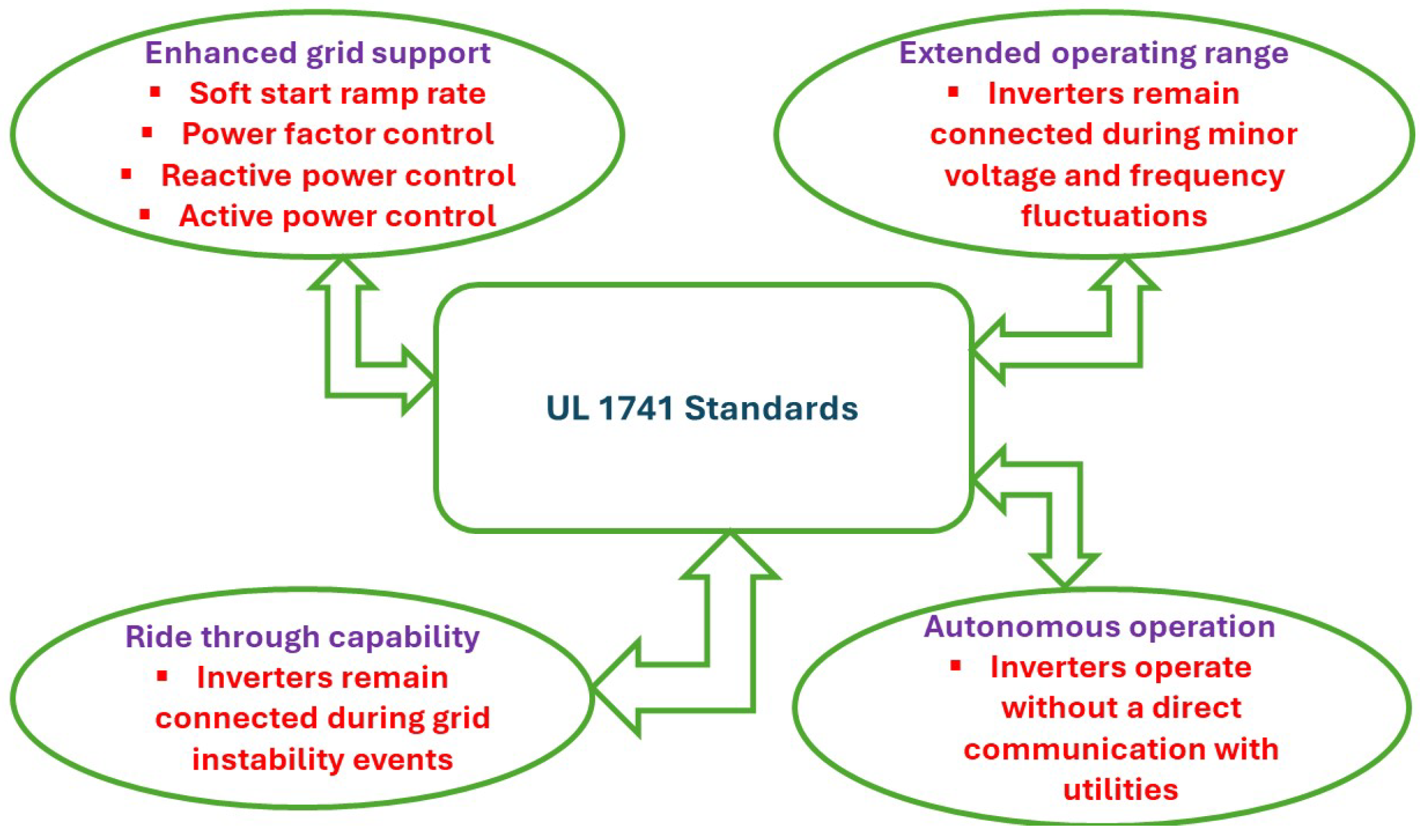
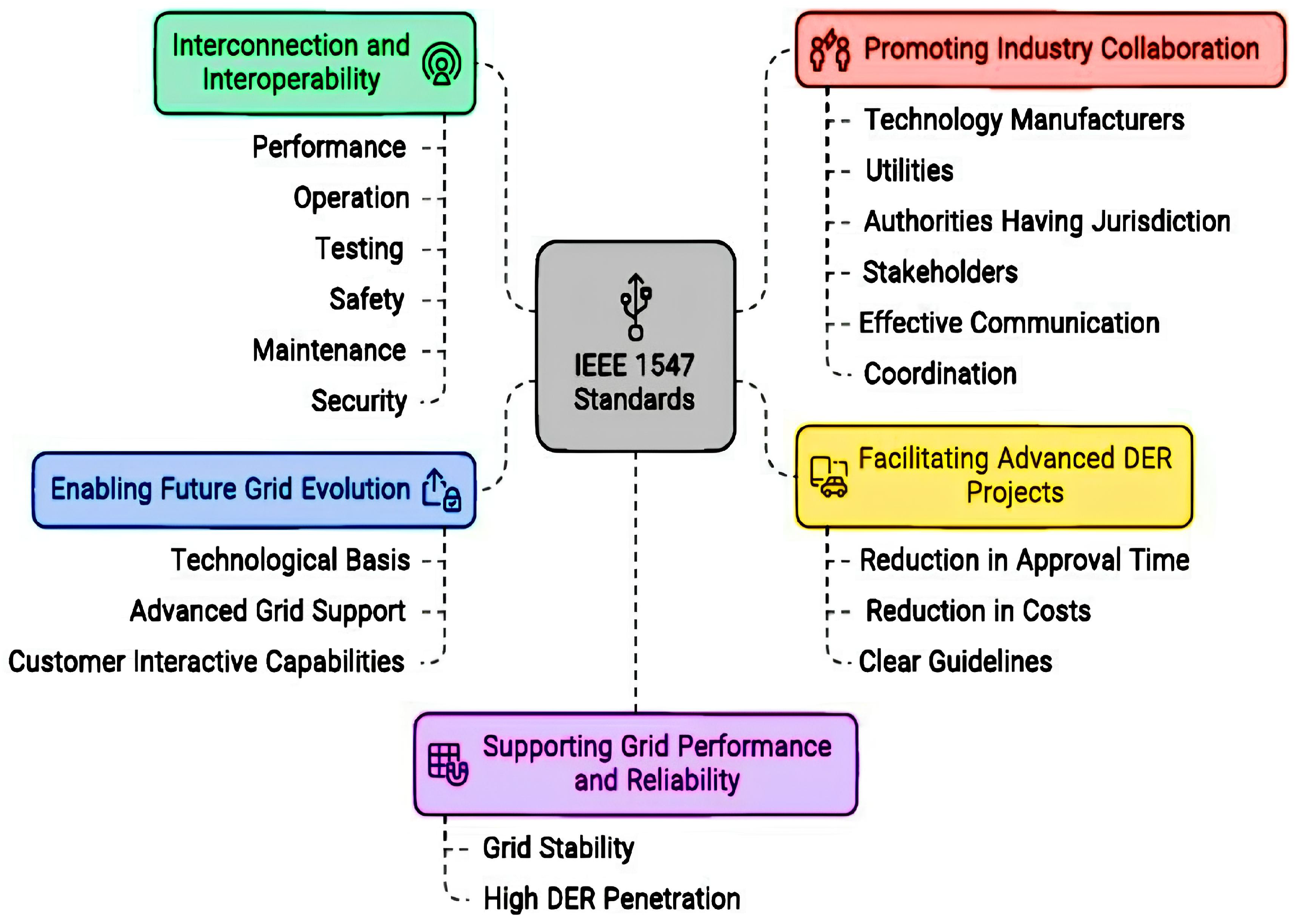
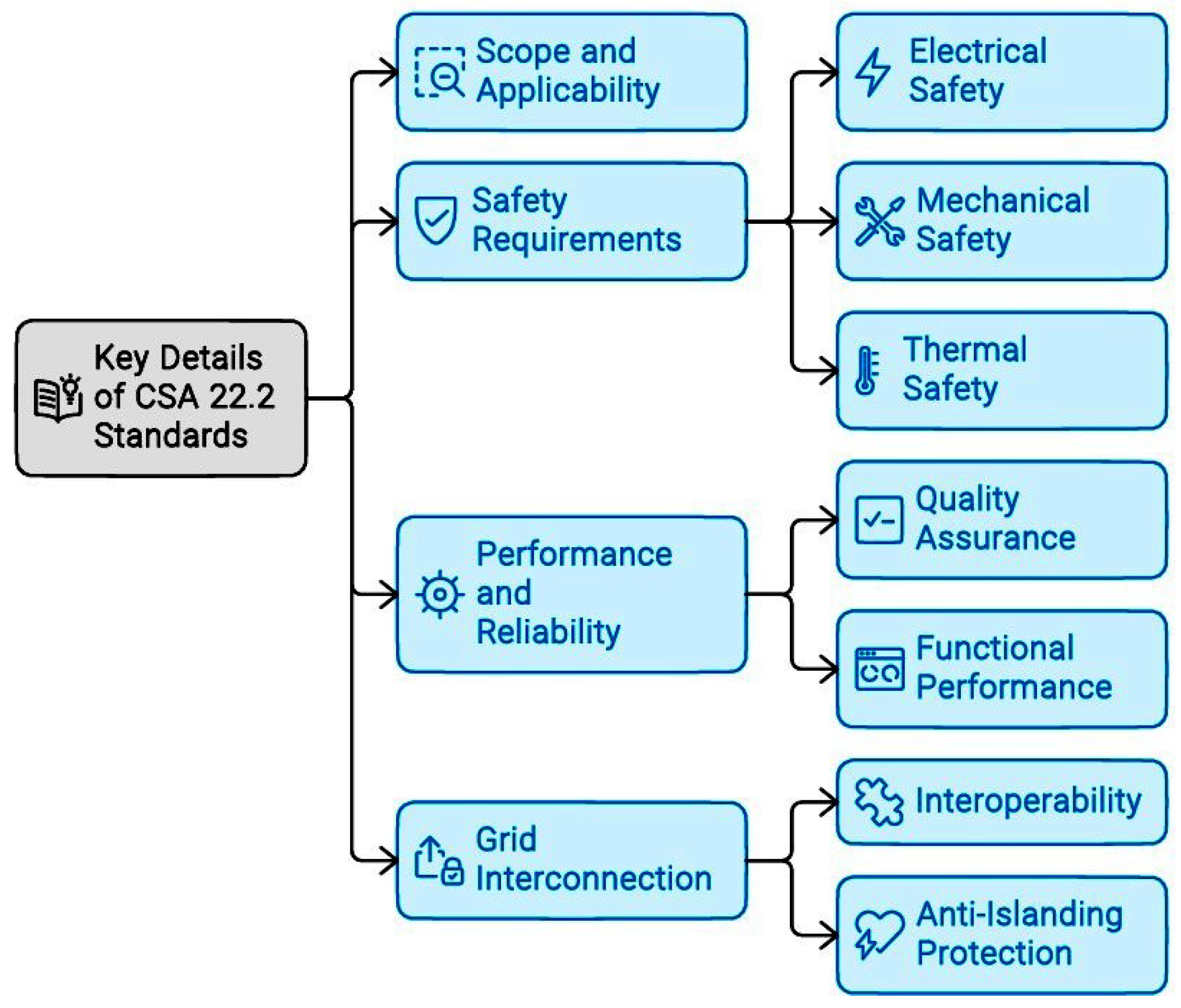
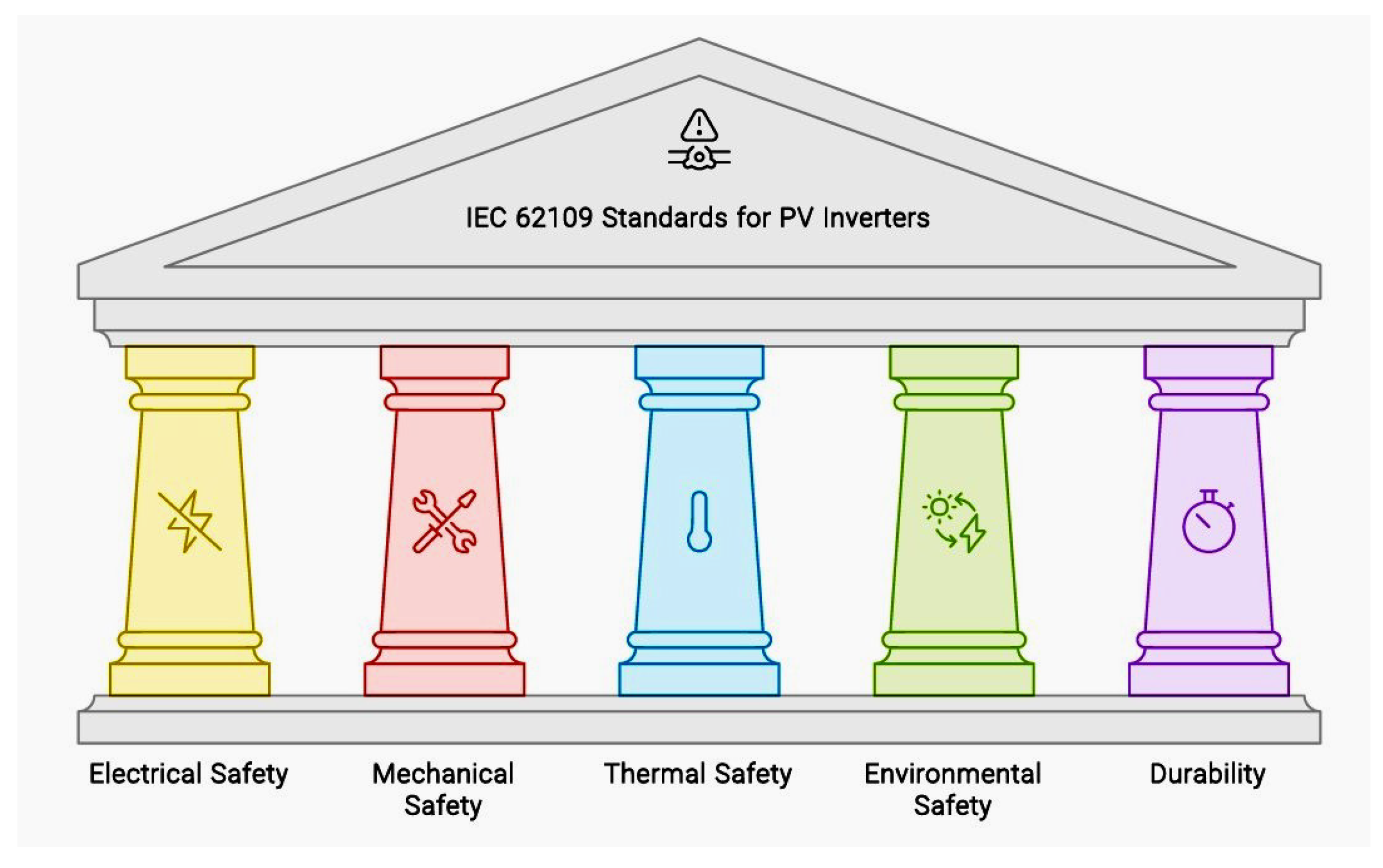
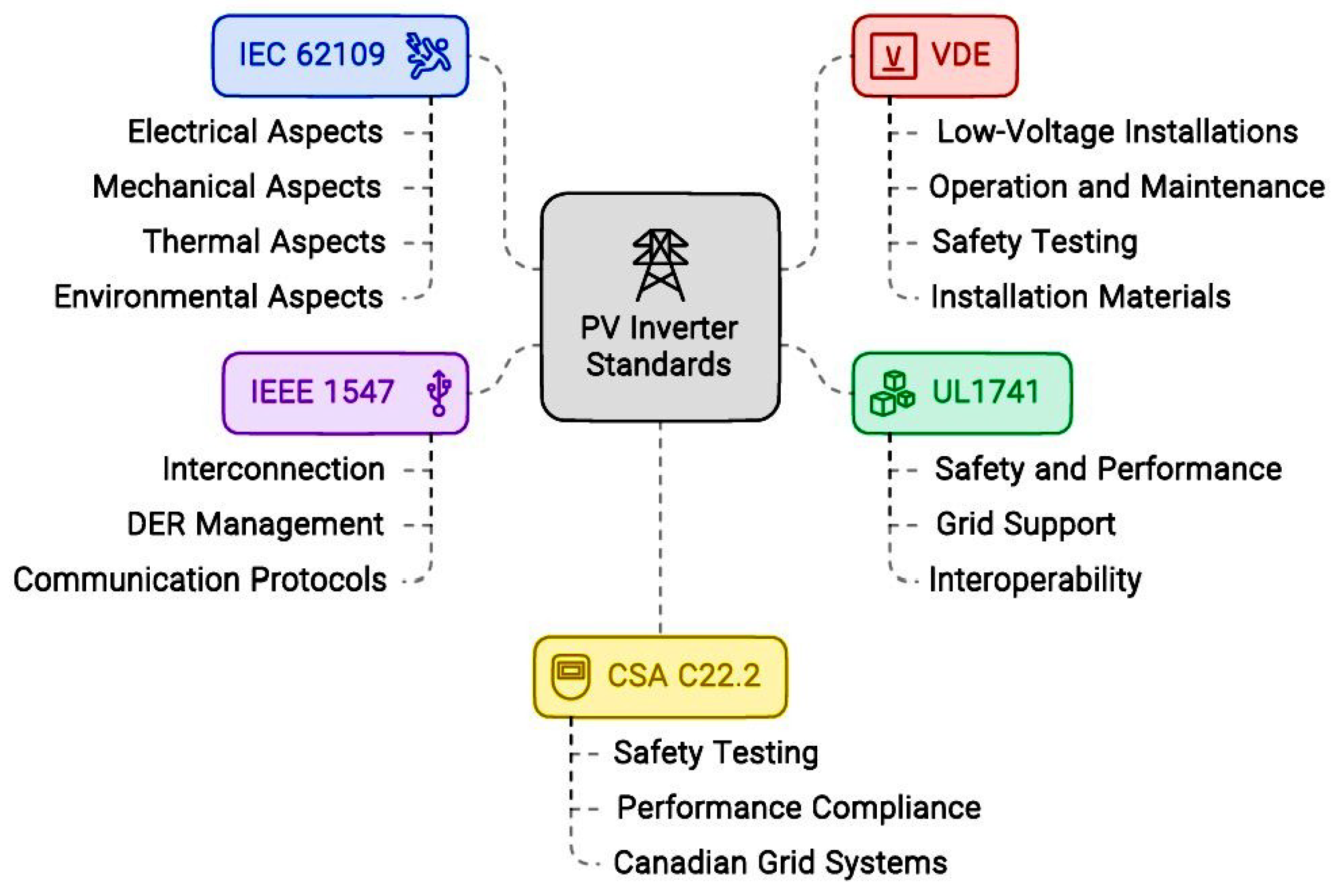

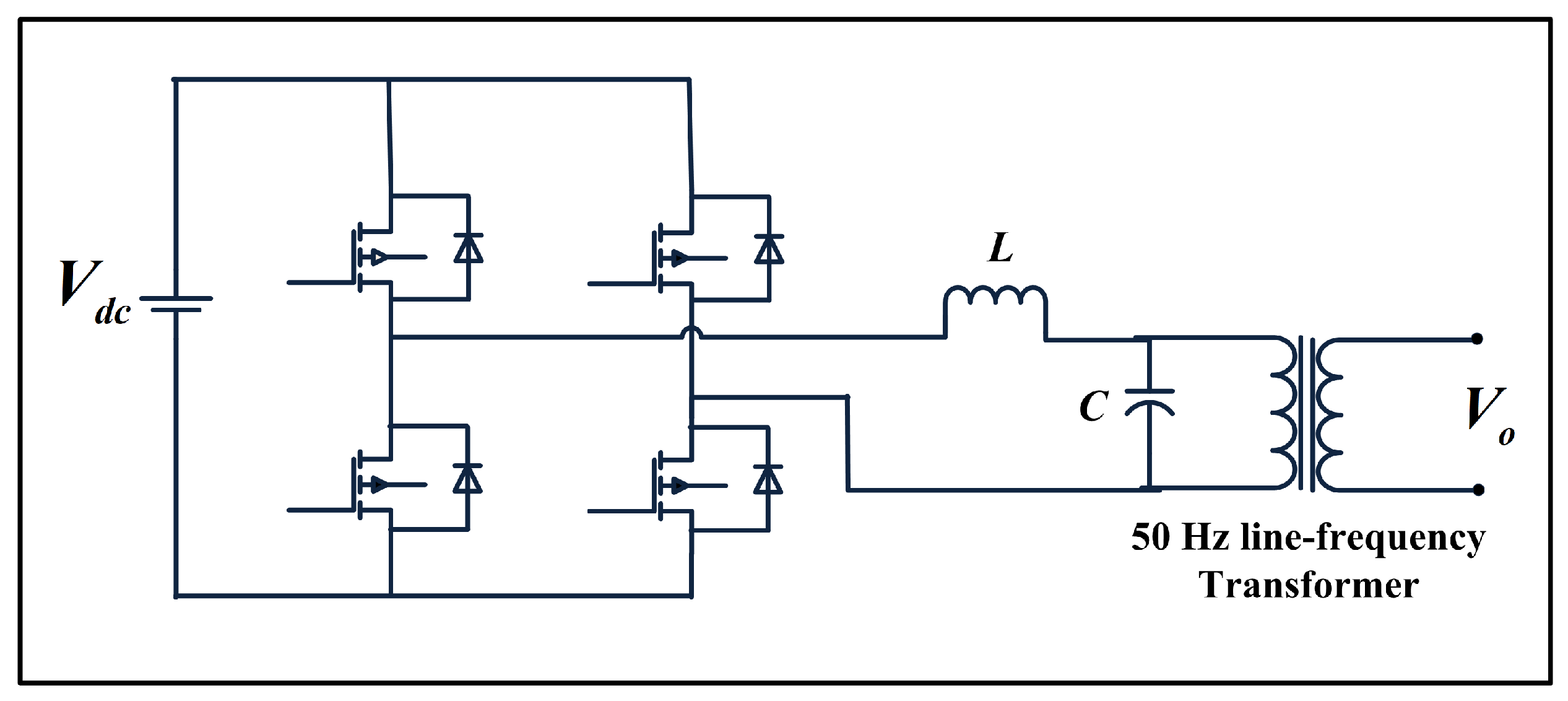
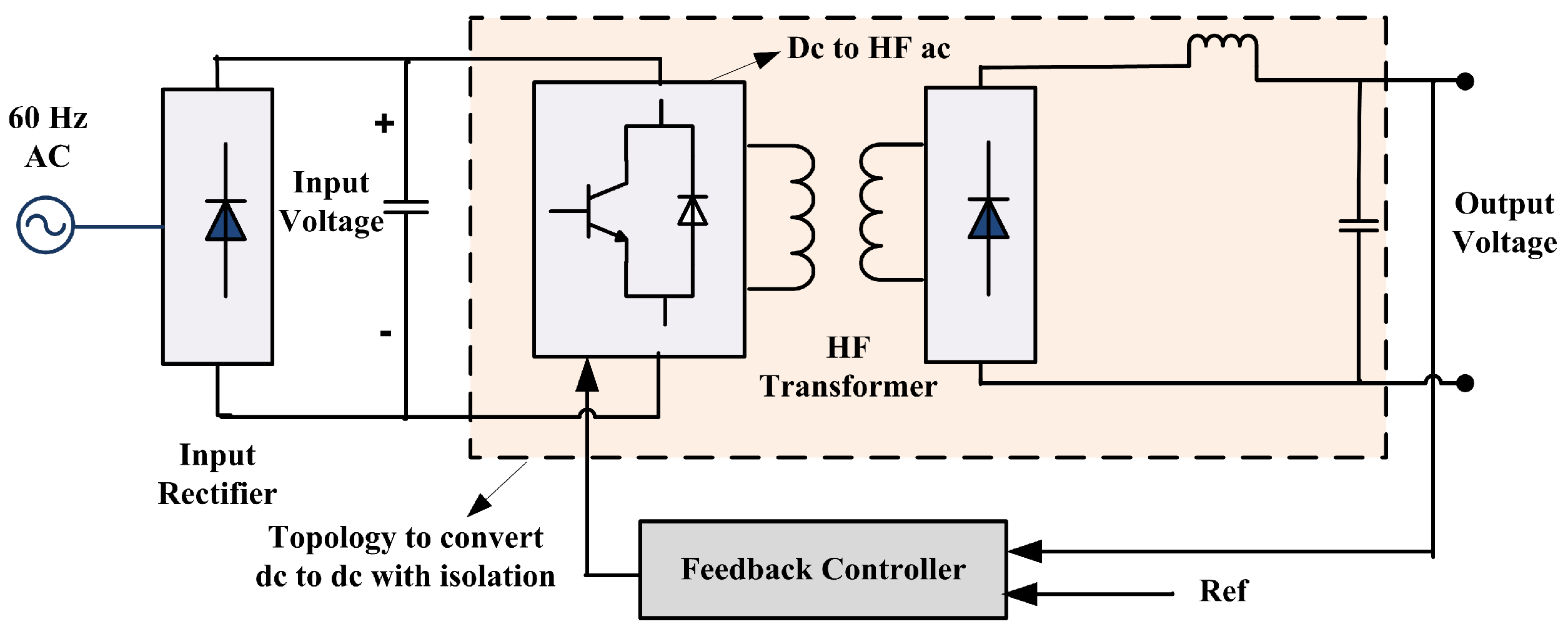
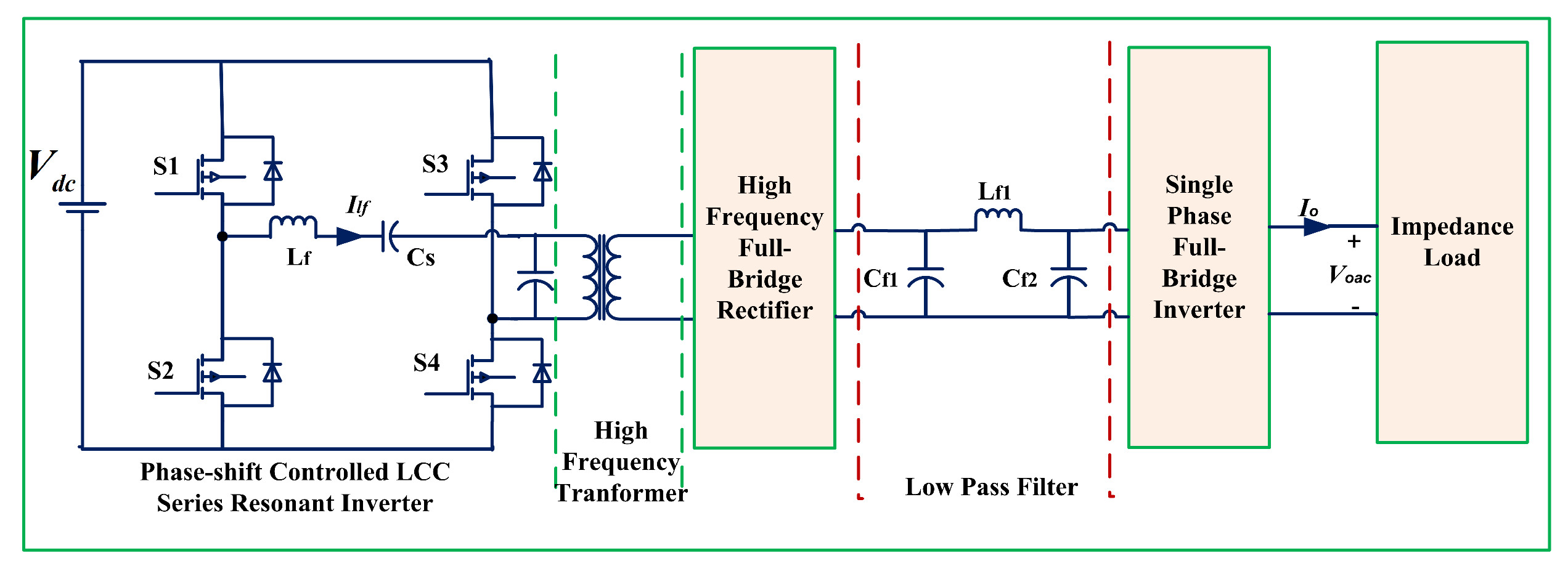

| Topology | Grid Support (UL1741) | Inter Connection (IEEE 1547) | Safety (CSA C22.2) | Reliability (IEC 62109) | Inter Operability (VDE) |
|---|---|---|---|---|---|
| Single-stage Inverters | 4 | 5 | 6 | 7 | 5 |
| Multi-stage Inverters | 8 | 9 | 8 | 9 | 8 |
| Boost and Buck-Boost | 7 | 8 | 7 | 8 | 7 |
| Two-stage Inverters | 9 | 9 | 9 | 10 | 9 |
| Line-frequency Inverters | 5 | 6 | 6 | 5 | 5 |
| Resonant Switching | 8 | 8 | 8 | 8 | 8 |
| Topology | Grid Support (UL1741) | Inter Connection (IEEE 1547) | Safety (CSA C22.2) | Reliability (IEC 62109) | Inter Operability (VDE) | Total Score |
|---|---|---|---|---|---|---|
| Single-stage Inverters | 20 | 20 | 18 | 28 | 15 | 101 |
| Multi-stage Inverters | 40 | 36 | 24 | 36 | 24 | 160 |
| Boost and Buck-Boost | 35 | 32 | 21 | 32 | 21 | 141 |
| Two-stage Inverters | 45 | 36 | 27 | 40 | 27 | 175 |
| Line-frequency Inverters | 25 | 24 | 18 | 20 | 15 | 102 |
| Resonant Switching | 40 | 32 | 24 | 32 | 24 | 152 |
Disclaimer/Publisher’s Note: The statements, opinions and data contained in all publications are solely those of the individual author(s) and contributor(s) and not of MDPI and/or the editor(s). MDPI and/or the editor(s) disclaim responsibility for any injury to people or property resulting from any ideas, methods, instructions or products referred to in the content. |
© 2024 by the authors. Licensee MDPI, Basel, Switzerland. This article is an open access article distributed under the terms and conditions of the Creative Commons Attribution (CC BY) license (https://creativecommons.org/licenses/by/4.0/).
Share and Cite
Hasan, M.A.; Vemula, N.K.; Devarapalli, R.; Knypiński, Ł. Investigation into PV Inverter Topologies from the Standards Compliance Viewpoint. Energies 2024, 17, 3879. https://doi.org/10.3390/en17163879
Hasan MA, Vemula NK, Devarapalli R, Knypiński Ł. Investigation into PV Inverter Topologies from the Standards Compliance Viewpoint. Energies. 2024; 17(16):3879. https://doi.org/10.3390/en17163879
Chicago/Turabian StyleHasan, Muhammad Asif, Naresh Kumar Vemula, Ramesh Devarapalli, and Łukasz Knypiński. 2024. "Investigation into PV Inverter Topologies from the Standards Compliance Viewpoint" Energies 17, no. 16: 3879. https://doi.org/10.3390/en17163879








